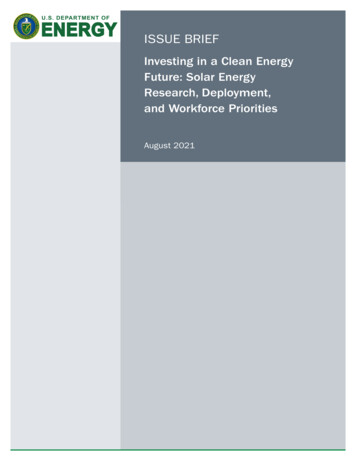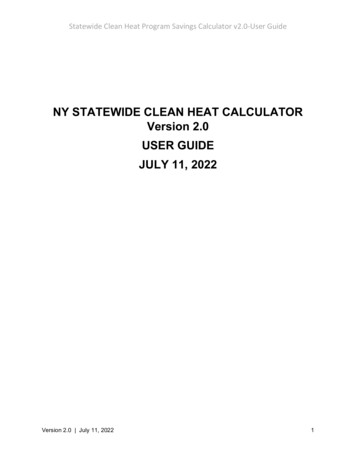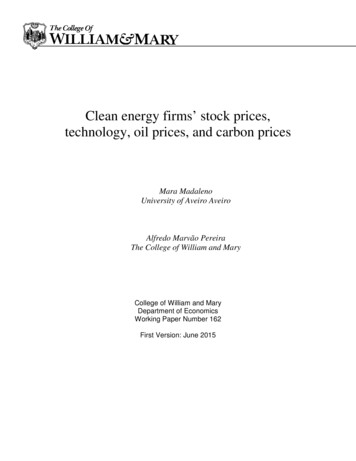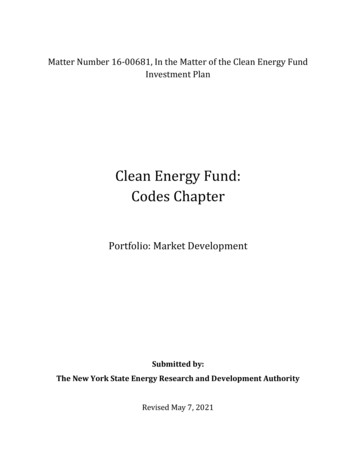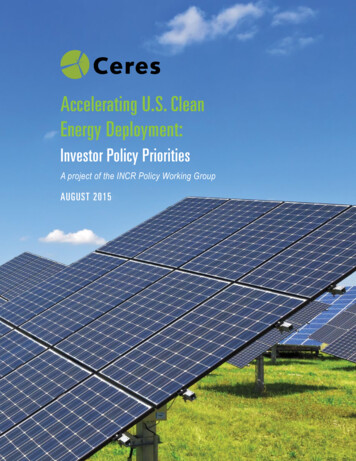
Transcription
Accelerating U.S. CleanEnergy Deployment:Investor Policy PrioritiesA project of the INCR Policy Working GroupAUGUST 2015
Acknowledgements:Ceres: Brandon Smithwood,Alli Gold Roberts, Aaron Pickering,Chris Davis, Sue Reid, Dan Bakal,Carol Lee Rawn, and Andrew LoganTABLE OF CONTENTSExecutive Summar y. 1Summary of U.S. Policy Priorities for 2015. 2Enable clean energy scale and equity .2Enable the evolution of the electric utility business model .2Support the scaling of clean transportation technologies.2Engaging the world’s largest investors in clean energy investmentrequires greater oppor tunities across investment por t folios . . . 3Direct investment in clean energy. . 4Direct investment in renewable energy infrastructure.4Direct investment in energy efficiency through real estate holdings.5Connecting institutional investors through semi-direct investments in infrastructure. 6Indirect investments in renewable energy project equity and debt.7Indirect investments in energy efficiency retrofit financing.7Indirect investments in advanced vehicles.9Indirect investment in clean energy infrastructure. 9Realizing opportunities and limiting risks in the electricity and transportation sectors. 10Electric utility sector. 11Transportation sector. 12Corporate clean energy adoption. 13Improved shareholder value through efficient real estate. 13Policy Implications and Recommendations. 14Enable clean energy scale and financial innovation. 16Scaling clean transportation . 17Enable the evolution of utility business models to lower risk and enable clean energy adoption. 18Support strong EPA rules to limit methane emissions from the Oil & Gas sector.20Conclusion.20
E XECUTIVE SUMMARY2015 is shaping up to be a pivotal year for climate policy internationally. In December,192 countries will convene in Paris to finalize a climate agreement intended to keep globaltemperature increases below two degrees Celsius.An agreement will come at a critical time. International investment to mitigate climate changeis far below levels needed to reach the two-degree target. The International Energy Agencyestimates that an average of an additional 1 trillion in incremental financing for clean energyis needed to meet the temperature target1—the “Clean Trillion.” Currently, global clean energyinvestment levels are about 25 percent of what is needed: 321 billion in 2014.2Institutional investors, and the corporations they invest in, are playing a growing role infinancing the clean energy infrastructure needed to meet international climate goals. Theseinvestors and companies must support policymakers who seek an international agreement thatwill provide clearer market signals and greater certainty for needed clean energy investments.In September 2014, over 350 investors representing 24 trillion in assets issued the GlobalInvestor Statement on Climate Change, calling on governments to create an ambitious globalagreement that includes a meaningful price on carbon.3 Climate change poses portfoliowide risks to institutional investors, while the technologies and business models needed toaddress climate change provide significant investment opportunities. Ceres has outlinedrecommendations for institutional investors, the companies they invest in, and policymakersto achieve the needed new investment of 1 trillion annually in its 2014 report, Investing in theClean Trillion: Closing the Clean Energy Investment Gap.4 Ceres and our U.S. and internationalinvestor network partners also recently released a guide for asset owners, Climate ChangeInvestment Solutions,5 as well as a web-based platform for identifying and recording climate,clean energy and decarbonization investments and commitments.6This paper connects the Clean Trillion goal to the current United States climate and clean energypolicy framework, which is a mixture of federal, state, and local initiatives. The paper outlinesthe 2015 U.S. policy priorities of the Policy Working Group of the Investor Network on ClimateRisk (INCR), a network of more than 110 institutional investors primarily based in the U.S.,focused on investment risks and opportunities associated with climate change.Protecting and scaling policies that help to bring institutional investors’ capital into cleanenergy will be key to achieving the pledge made by the United States to reduce emissions by 17percent by 2020 and by 26-28 percent by 2025. Strong and credible U.S. targets will be key, inturn, to achieving an international agreement in Paris. With clear policy frameworks in place,institutional investors are poised to play a greater role in financing clean energy.1 International Energy Agency (IEA), Energy Technology Perspectives 2012: Pathways to a Clean Energy System, (Paris: OECD/IEA, 2012), 1, http://www.iea.org/etp/etp2012/2 Bloomberg New Energy Finance, “Clean Power Investment Declines 0.2% to 73.5 Billion,” July 13th, 2015, stor Network on Climate Risk et al, Global Investor Statement on Climate Change, September 18th, 2014, http://investorsonclimatechange.org/4 Mark Fulton and Reid Capalino, Investing in the Clean Trillion: Closing the Clean Energy Investment Gap, Ceres, January 2014, www.ceres.org/issues/clean-trillion5Investor Network on Climate Risk et al., Climate Change Investment Solutions Guide, April 22, 2015, http://bit.ly/1cONmOM.6The Investor Platform for Climate Solutions, http://investorsonclimatechange.org.Accelerating U.S. Clean Energy Deploymen: nvestor Policy Priorities1
Any policy framework that hopes to bring institutional investors’ capital to financing cleanenergy infrastructure should consider impacts across a diversified portfolio, since institutionalinvestors typically invest broadly across asset classes and industries. Already, investors(including pension funds, mutual funds, and insurance companies) are investing in green bonds,new instruments like YieldCos, private equity funds financing renewable energy projects, and arange of companies producing or using clean energy services and products.SUMMARY OF U.S. POLICY PRIORITIES FOR 2015Institutional investors are uniquely positioned to support the growth of a low-carbon economy,and we recommend that federal and sub-national policymakers support policies that enable thescaling-up of clean energy deployment that drives technology, business model, and financialinnovation. Such policies should provide connections between needed clean energy technologyin key sectors and the investment needs and portfolios of institutional investors in the UnitedStates. To this end, INCR’s key policy priorities for 2015 include:Enable clean energy scale and equity1) Provide stability for the federal production tax credit for wind, investment tax credit forsolar, and accelerated depreciation for renewable energy;2) Expand Master Limited Partnerships and Real Estate Investment Trusts to includerenewable energy; and3) Adopt city building benchmarking and disclosure ordinances that provide transparency onthe energy efficiency of the 800 billion Real Estate Investment Trust industry.Enable the evolution of the electric utility business model4) Maintain and expand state climate and clean energy standards (renewable energy, energyefficiency, AB32, RGGI, etc.);5) Develop robust final rules for the Environmental Protection Agency’s Carbon PollutionStandards for new and existing power plants and ensure strong implementation by statesthrough proven policies, such as renewable portfolio standards and energy efficiencyresource standards; and6) Remove legal barriers that prevent companies and other electricity consumers fromentering into third-party power purchase agreements with renewable energy developers.Support the scaling of clean transportation technologies7) Support the adoption of rigorous federal fuel economy and GHG emission standards forheavy-duty trucks;8) Support the preservation of the Corporate Average Fuel Efficiency (CAFE)/GHG standardsfor passenger vehicles and light trucks; and9) Adopt and expand state-level clean fuel standards.This is a pragmatic and achievable agenda rather than a set of principles and ideal policyoutcomes. Both the U.S. and international policy environments are falling short of the levelof ambition needed to achieve the internationally adopted goal of limiting global temperaturerise to no more than two degrees Celsius.7 Ultimately, a key goal of INCR, as noted in the7 Henry D. Jacoby and Y.-H. Henry Chen, Expectations for a New Climate Agreement, MIT Joint Program on the Science and Policy of Global Change, August2014, GC Rpt264.pdf2www.ceres.org
Global Investor Statement, is a meaningful price on carbon in the U.S. and internationally. Inthe interim there is much that can be achieved with the pragmatic agenda outlined above anddiscussed at further length in this paper. Part of the pragmatism of this agenda is a recognitionof both the current partisan divide in the U.S. Congress and many state legislatures on climateand clean energy issues, and the current investment practices of U.S. institutional investors andthe limitations to – and opportunities for – greater investment in clean energy.ENGAGING THE WORLD’S L ARGEST INVESTORS INCLE AN ENERGY INVESTMENT REQUIRES GRE ATEROPPORTUNITIES ACROSS INVESTMENT PORTFOLIOSInstitutional investors manage a massive pool of capital that could be tapped to scale up cleanenergy finance. Thus far, however, institutional investors have not been a leading source ofcapital for clean energy. Pension funds and insurance companies only accounted for 22billion (or 2.5 percent) of clean energy asset finance globally from 2004-2011.8 This is despiteestimates that institutional investors could invest 819 billion globally, even after accounting fordiversification, industry concentration limits, and other restrictions.9Currently, there are a limited number of clean energy investment vehicles available forinstitutional investors. Institutional investors typically invest for broad diversification acrossmultiple asset classes and primarily invest in publicly listed securities like stocks and bonds.It is in this area where investment opportunities have been particularly lacking. Indeed, whenappropriate investment vehicles – such as rated “green” bonds – have been available, they havebeen met with institutional investor demand that far exceeds supply.10A look at how institutional investors allocate their capital demonstrates the gap betweenthe capital needed for clean energy and the investment needs and practices of the investors.Currently, renewable energy and energy efficiency infrastructure investment predominantlycomes from private capital sources. Wind farms, solar generators, and energy efficiency retrofitsare typically financed through corporate balance sheets, bank loans, and other forms of privateequity and debt. Institutional investors, however, only have limited exposure to the entire set ofprivate equity asset classes. While U.S. pension funds may invest in private equity funds that inturn invest in renewable energy infrastructure, private equity generally constitutes a relativelysmall portion of a pension funds’ investments, and clean energy is only a small portion of thatallocation. Furthermore, diversification requirements often dictate that energy investmentsonly constitute a relatively small portion of those investments. Pension funds in the UnitedStates have, in aggregate, just 29 percent of their assets in private equity and other alternative8 Kaminker C. and F. Stewart, “The Role of Institutional Investors in Financing Clean Energy,” OECD Working Papers on Finance, Insurance and PrivatePensions, No. 23, OECD Publishing, 2012, 20-22, http://www.oecd.org/environment/WP 23 gy.pdf9 Note that this estimate excludes investment managers. Climate Policy Initiative (CPI), The Challenge of Institutional Investment in Renewable Energy, March2013, 18, ent-in-Renewable-Energy.pdf. CPI estimates 257billion available for direct project investments, which it then breaks down into 66 billion for project equity and 290 billion for project debt. CPI then estimates upto another 562 of investment via pooled investment vehicles ( 272 billion project equity and 290 billion project debt).10 The Climate Bonds Initiative and HSBC, Bonds and Climate Change: the state of the market in 2014, July 2014, 6, July2014-A4-final.pdfAccelerating U.S. Clean Energy Deploymen: nvestor Policy Priorities3
Private Equity,Debt, & otherAlternativeInvestments2%44%29%69%CashPublic Equity25%EquityBondsFigure 1: Typical U.S. Pension Fund Asset Allocationinvestments. About 2 percent of assets are held as cash. The remaining 69 percent of a typicalU.S. pension funds’ assets are in public capital markets, primarily listed equities (stocks) andfixed-income (bonds).11Given the disconnect between current capital sources for clean energy and the asset allocationsof institutional investors, any policy framework should consider the impacts of policy not onlyon (1) direct investment by institutional investors, but also (2) semi-direct investment infunds and new, publicly-traded-vehicles for infrastructure investment, as well as (3) indirectinvestment in clean energy infrastructure through corporations in which these investorsare shareholders. Table 1 provides an overview of the spectrum of categories of investmentopportunities.DIRECT INVESTMENT IN CLEAN ENERGYDirect investment in renewable energy infrastructureAmong U.S. pension funds, mutual funds, insurance companies and other large institutionalinvestors, equity investment in wind farms, solar power plants, energy efficient buildings andretrofit projects and other clean energy infrastructure is limited. As mentioned above, theseinvestors generally do not participate in equity or debt financing of individual projects, let aloneenergy projects. However, while direct investment is constrained, it is nonetheless significant.There has been some direct investment in renewable energy projects through project bonds.These project bonds raise debt based on the revenues of a single project. In 2013, 3.1 billionof project bonds were issued, including over 1 billion just to finance Berkshire Hathaway’sTopaz Solar project.12 While Bloomberg New Energy Finance predicts that such project bondfinancings could support 18-40 billion in annual project financing or refinancing by 2020,13most renewable energy projects are too small for project bond financing and require aggregationof numerous projects in order to be financed through bonds.11 Towers Watson, Global Pension Assets Study 2015, February 2015, 7, t-Study-201512 Bloomberg New Energy Finance, Green Bonds Market Outlook 2014, June 2 2014, 16, 14-06-02-Green-bonds-market-outlook-2014.pdf13 Bloomberg New Energy Finance, Green Bonds Market Outlook 20144www.ceres.org
ASSET CLASSDirect investmentSemi-direct investmentIndirect investmentVEHICLES FOR INVESTMENTPrivate equity and debtPrincipal in unlisted green infrastructure projectsthrough equity, debt, or mezzanine financingPublic debtProject bondsPrivate equityInvestment in pooled vehicles such as:- infrastructure venture capital/private equity fundsthat invest in projects- private placement asset backed securitiesPublicly-traded debt or equityInvestment in pooled vehicles such as:- asset backed securities- Master Limited Partnerships- Real Estate Investment Trusts- YieldCosPrivate debtPrivate placement corporate bondsPublicly-traded debt or equityDebt:- Publicly listed equity or corporate bonds and othergreen bondsEquity:- Infrastructure venture capital/private equity fundsthat invest in companies- Increased shareholder value from companiesdiversifying into clean energy technology/servicesOR using technologies/services for their ownoperationsTable 1: Ways for Institutional Investors to Finance Clean EnergyIn other parts of the world, institutional investors—such as the Netherlands’ AP4,PensionDanmark, various Australian Superannuation funds, and the insurance companyMunich Re—invest directly and substantially in clean energy projects. Research done by theClimate Policy Initiative suggests that more institutional investors, including those in the U.S.,could invest in renewable energy projects if they have enough scale to justify having a dedicatedenergy project team. By their calculation, a pension fund with over 50 billion in assets hassufficient scale.14 The universe of investors of this scale, however, is relatively small. Accordingto Towers Watson’s most recent ranking of the world’s largest pension funds, fewer than 30federal, state, and private pension funds in the U.S. have over 50 billion in assets.15 Especiallygiven this limited universe of investors, any policy framework that hopes to scale renewableenergy investment by institutional investors must look beyond direct investment.Direct investment in energy efficiency through real estate holdingsWhile it is rare for institutional investors to invest directly in energy generation projects, anumber of U.S. institutional investors do own buildings directly. Through these buildings,investors have an opportunity to directly benefit from the financial returns associated with moreenergy efficient buildings.Efficient buildings have consistently shown significant returns to property owners in terms ofhigher rents, building value increases, and higher occupancy rates, which can lead to increasedvalue for investors. McGraw Hill Construction has analyzed a range of financial benefits fromimproving building efficiency. Among their findings: building values increase between 6 and 10percent and rents rise by up to 6 percent.16 Another large study examined 10,000 buildings14 Climate Policy Initiative, 3515 Towers Watson, The World’s 300 Largest Pension Funds- year end 2013, September 2014, rgest-pension-funds-year-end-201316 McGraw Hill Construction, Green Outlook 2011: Green Trends Driving Growth, November 2010, utlook2011.pdf. Ranges result from differences between retrofits and new buildings.Accelerating U.S. Clean Energy Deploymen: nvestor Policy Priorities5
Green Bonds: Defining anEmerging Asset ClassGreen bonds are a rapidly growingbut not clearly defined universe ofinvestments. Pioneered by developmentbanks nearly a decade ago, green bondshave grown dramatically. The market forlabeled green (or “climate”) bonds hasbeen estimated at 38 billion17 to a halftrillion dollars ( 502 billion)18 dependingon definition. These bonds includefinancing for traditional investments thathave the benefit of reducing greenhousegas emissions, such as governmentbonds to finance public transportation.Green bonds also encompass morenovel investments, such as corporatebonds that are “ring-fenced” to financeclean energy projects or solar assetbacked securities. Given the broaduniverse of green bonds, and theambiguity around their definition, Ceresconvened a number of large institutionalbond purchasers to develop a set of“investor expectations” for green bonds.These Investor Expectations build on,and complement, the 2014 Green BondPrinciples developed by banks thatstructure and sell bonds19 by addressingfour key areas that need greaterdefinition and structure: 1) eligibilitycriteria, 2) disclosure of use of proceeds,3) reporting on use of proceeds andimpacts, 4) independent assurance.2017 Bloomberg New Energy Finance, “Rebound in Clean EnergyInvestment in 2014 Beats Expectations,” January 9 2015, -energy-investment-2014-beatsexpectations/18 The Climate Bonds Initiative and HSBC, 2014, 319 Bank of America, Citigroup, Credit Agricole, et al. “Green BondPrinciples Created to Help Issuers and Investors Deploy Capital forGreen Projects,” January 13, 2014, deploy-capital-for-green-projects20 Ceres, “A Statement of Investor Expectations for the Green BondMarket,” February 10, 2015, t-of-investor-expectations-for-green-bonds/at download/file6www.ceres.orgevaluated for energy efficiency, comparing efficientbuildings with buildings nearby that are similar inall other respects. This study found that buildingswhich have earned Energy Star or LEED ratingsoutperform their peers on a number of metricsincluding per-square-foot rental rates that are 3percent higher, overall rents that are 7 percenthigher, and selling prices that are 16 percent higher.21Given the benefits of energy-efficient real estate,investors have been making properties they ownmore efficient. The California Public Employees’Retirement System (CalPERS), which has a realestate portfolio of over 25 billion, worked withcore real estate investment managers to pursue a20 percent energy reduction. CalPERS exceededits goal. The California State Teachers RetirementSystem (CalSTRS) has, since 2003, directed realestate managers for its separate accounts to assessbuilding sustainability annually. The result has beena dramatic improvement of the energy performanceratings of buildings in the portfolio. In 2007, lessthan half (46 percent) of the buildings in CalSTRS’sportfolio had an Energy Star score above 75; by 2014,86 percent of buildings achieved that rating.Most institutional investors in the United States,however, do not own buildings directly, just asthey do not directly invest in renewable energyinfrastructure. There is therefore a need for semidirect investment vehicles that can provide exposureto clean energy opportunities in renewable energy,efficient real estate, and beyond.CONNECTING INSTITUTIONAL INVESTORS THROUGH SEMIDIRECT INVESTMENTS IN INFRASTRUCTUREGiven the limitations to direct investment in cleanenergy infrastructure, indirect investment optionsopen clean energy investment to a much broaderuniverse of investors. New publicly-traded, semidirect investment vehicles are emerging to fill thisneed. Such publicly traded vehicles are critical toattracting a broader universe of investors who needliquid investment opportunities, but want exposureto the attractive financial characteristics of cleanenergy projects, including their typical stable cashflows that come from long-term contracts withenergy offtakers.21 Eichholtz et al., Doing Well by Doing Good? Green Office Buildings, The AmericanEconomic Review, December 2010
Indirect investments in renewable energy project equity and debtThe emerging equity option of choice for financing renewable energy projects is the YieldCostructure. YieldCos are publicly traded corporate entities that provide some of the benefits ofinvesting directly in electricity generation projects while providing the liquidity of a publiclytraded security. A number of YieldCos have been created just in the past two years, includingPattern Energy (PEGI), NextEra Energy Partners (NEP), TerraForm Power (TERP), and NRGYield (NYLD).22Though small in scale thus far, there are numerous debt instruments coming onto the market.These investments in clean energy infrastructure debt are part of a burgeoning green/climatebond market (see sidebar, “Green Bonds: Defining an Emerging Asset Class”). A portion of thisfinancing is flowing to clean energy infrastructure through indirect investment vehicles, suchas asset-backed securities. In 2013, Hannon Armstrong Sustainable Infrastructure issued 100million in bonds backed by clean energy projects. SolarCity followed later in the year with anissuance of 54.4 million in bonds, and the company has subsequently sold bonds backed byadditional pools of solar projects.23 Expect to see additional clean energy bond issuances frommore issuers in the future.Indirect investments in energy efficiency retrofit financingIndirect financing opportunities remain limited for energy efficiency, trailing behind renewableenergy. This is despite the estimated 279 billion investment opportunity in retrofitting U.S.buildings.24 Constraints on the institutional investment needed to realize this opportunity wereoutlined in Ceres’ report, Power Factor: Institutional Investors’ Policy Priorities Can BringEnergy Efficiency to Scale.25 The key constraint is a lack of appropriate investment vehicles.Securitization and other forms of indirect investment will be needed so that numerous smallprojects can be aggregated for financing.There have been a handful of energy efficiency securitizations, such as a 24.3 million issuanceby the New York State Energy Research and Development Authority (NYSERDA)26 and aprivate placement of bonds issued by Citi from Pennsylvania’s Keystone HELP residentialenergy efficiency retrofit program.27 Most notably, the Western Council of Governments’ HEROprogram issued a rated bond, which was backed by property-assessed clean energy (PACE) loansmade to numerous homeowners in California. A number of others look to be on the horizon,with Citi creating a 100 million credit facility28 to finance projects developed by KilowattFinancial, and Renewable Funding securing a 300 million credit facility to finance PACEfinanced projects.29 Kilowatt Financial and Renewable Funding both ultimately seek to securitizethe loan portfolios financed by these funds.22 Giles Parkinson, “ 1 trillion solar, wind finance to outstrip oil and gas industry,” RE New Economy, July 20, 2015, 3 Bloomberg New Energy Finance, Green Bonds Market Outlook 2014, June 5, 2014, ket-outlook-2014/24 DB Climate Change Advisors and The Rockefeller Foundation, United States Building Energy Efficiency Retrofits: Market Sizing and Financing Models,March 2012, http://www.rockefellerfoundation.org/25 Ceres, Power Factor: Institutional Investors’ Policy Priorities Can Bring Renewable Energy to Scale, May 2013, available at: n-bring-energy-efficiency-to-scale/view26 “NYSERDA Issues Energy Efficiency Financing Bonds”, Breaking Energy, August 23, 2013, s-energyefficiency-financing-bonds/27 Anya Litvak, “Looking for loans with an energy angle,” Pittsburg Post-Gazette: Power Source Blog, October 6th, 2014, ith-an-energy-angle/stories/20141006021728 Stephen Lacey, “Energy Efficiency is About to Get a 200M Jolt from Wall Street”, Greentech Media, January 22, 2014, Street29 Jeff St. John, “PACE on the Rebound: Renewable Funding Closing 300M Credit Facility,” Greentech Media, May 9, 2014, t-facilityAccelerating U.S. Clean Energy Deploymen: nvestor Policy Priorities7
Case Study: Solar City Leverages Policy to Scaleand Reaches the Public Capital MarketsSolarCity (SCTY) went public in December 2012, with an initial public offering on the NASDAQstock exchange. However, its most interesting contribution to the public capital markets came inNovember 2013, when Solar City became the first company to issue bonds backed by revenuesfrom the power purchase agreements they enter into with customers. The company issued asecond round of bonds in March of 2014
Chris Davis, Sue Reid, Dan Bakal, Carol Lee Rawn, and Andrew Logan. Accelerating U.S. Clean Energy Deploymen: nvestor Policy Priorities 1 EXECUTIVE SUMMARY 2015 is shaping up to be a pivotal year for climate policy internationally. In December,
